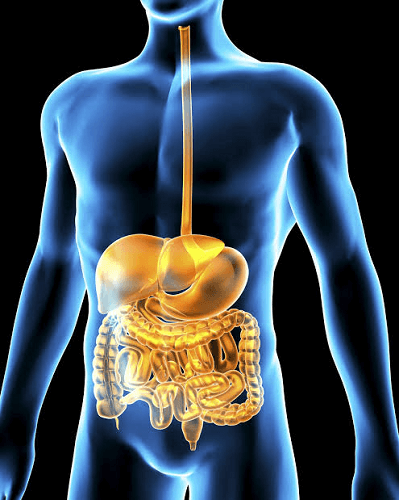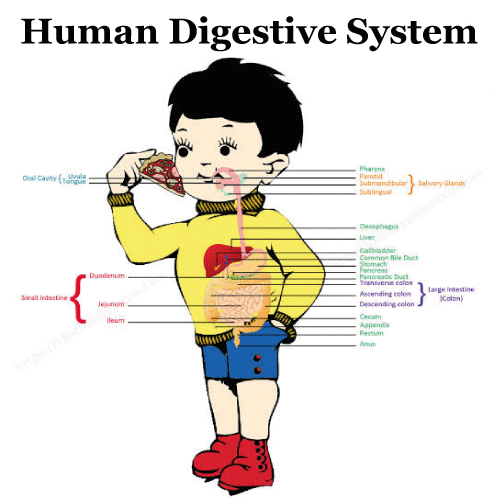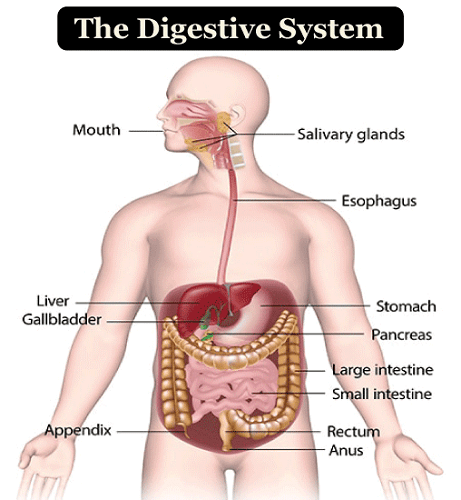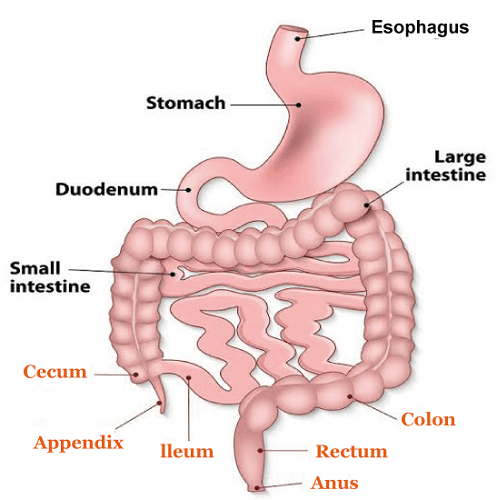Digestive System DefinitionThe digestive system consists of the gastrointestinal tract, liver, pancreas, and gallbladder. It is responsible for breaking food and beverages into their basic active compounds such as lipids, proteins, and carbs. The body then consumes them for nutrients, which can subsequently be used as energy to create and repair cells, as well as to help you function. The digestive system's function begins when foodstuff enters the body and moves through the esophagus and stomach where digestion takes place. 
The small intestine subsequently digests the meal and absorbs nutrients before releasing them into the bloodstream. The remaining food becomes liquid and flows to your big intestine. The water is absorbed by the large intestine wall, and the remaining indigestible food is excreted. The small intestine is divided into three sections. The duodenum is the first segment of the digestive tract. The ileum is at the bottom, whereas the jejunum is in the center. The appendix, colon, cecum, and rectum are all parts of the large intestine. The appendix is a finger-shaped pouch that is attached to the cecum. The cecum is the small intestine's initial portion. The colon comes next. The rectum is the last of the big intestine. Importance of DigestionDigestion is vital because our body wants the nutrients we consume by eating and drinking to function properly and remain healthy. The digestive system breaks down nutrients so that the body may receive and utilize them for energy, growth, and cell repair. Nutrition is made up of proteins, fats, carbs, vitamins, minerals, and water.
The small intestine collects most nutrients from meals, and the circulatory system transfers them to other body regions for storage or utilization. Specific cells help nutrients move from the gut lining into circulation. Simple carbs, amino acids, glycerol, and vitamins and minerals are transported to our liver by our blood. As needed, our liver stores transport, and creates nutrients for the rest of our body. The lymph system oversees fatty acid and nutrient absorption. It is a capillary network that carries white blood cells and a fluid called lymph all through the body to fight disease. 
The digestive system is the essential connection between eating and getting enough nourishment to enable the body to function. The human body with a healthy digestive system will consist of
If your digestive system is weak, you may not be getting all the nutrients and energy from the food you eat. The body is accustomed to single-ingredient foods in their natural state like Wholegrains and legumes, Fruit and vegetables, Protein and lean meat, and Unsaturated fats, and nuts will digest more quickly. Food high in sugar, processed foods with additional preservatives and emulsifiers, fatty meat, and convenience foods can all slow down the digestion process. How Does the Digestive System Work?Each part of our digestive system helps to transfer food and fluids throughout our GI tract by breaking them down into smaller pieces, or both. As food is broken down into small enough pieces, our bodies can absorb and transport nutrients to where it is required. The large intestine receives water and excretes waste in form of a bowel after digestion. Nerves and hormones help to regulate the digestion process by controlling it. Parts of the Human Digestive SystemThe human digestive system is a collection of organs that work together to transform food into energy and other essential nutrients for the body. Our bodies digest and utilize the food we consume, and the unused portions of the meal are excreted. The gastrointestinal tract (alimentary canal) and associated organs comprise the human digestive system. These two ingredients operate in tandem to help digestion. The alimentary canal is a long tube by which our food passes When the food particles pass through the numerous compartments of the alimentary canal, they are gradually digested. Organs that assist digestion but are not components of the gastrointestinal tract are classified as accessory organs. They promote digestion by circulating enzymes that aid in meal breakdown. 
Let us take a closer look at the human digestive system, including its functions and parts. MouthWhen we eat, food begins to flow through our GI tract. When we swallow, our tongue pushes the food into our throat. To prevent choking, the epiglottis is a little flap of tissue that wraps around our windpipe by enabling the food to pass through our esophagus. TongueThe tongue, a muscular organ found on the floor of the mouth, is a dynamic structure that plays a vital role in motor processes such as speaking, eating, and swallowing. It works with the cheeks to guide and hold food between the top and bottom teeth until mastication is complete. The movement of the tongue assists in the development of negative pressure inside the oral cavity, allowing infants to suckle. The tongue is an important peripheral sense organ because it contains groups of special epithelial cells called taste buds that transport impulses from the oral cavity to the central nervous system. Moreover, the glands on the tongue produce some of the saliva required for swallowing. PharynxThe terminal end of the Mouth is connected by a fibromuscular y-shaped tube. It mostly transports chewed or crumbled food from the mouth to the esophagus. The passage of air from the nasal cavity towards the lungs through the pharynx is essential to the respiratory system. EsophagusPeristalsis occurs when our brain delivers a signal to our esophageal muscles. It becomes instinctive once we begin to swallow. Lower oesophageal sphincter.When food gets to the bottom of your esophagus, a thin circular muscle called the lower oesophageal sphincter relaxes and lets food enter into your stomach. Normally, this sphincter closes to avoid stomach contents from flowing back into the esophagus. StomachWhen food reaches our stomach. It will be combined with digestive juices by the stomach muscles. The stomach contents known as chyme will gradually empties the small intestine. This vital organ acts as a food storage organ by allowing for proper food to digest. It functions as a muscle bag on the left side of abdominal cavity, beneath the diaphragm. To aid digestion, the stomach generates digestive enzymes, including hydrochloric acid. MucousMucous membranes secrete aqueous discharge. It guards the stomach lining as well as gastric pits out from acid produced by the glands to kill bacteria which enter food particles. Digestive enzymesPolymeric macromolecules such as biopolymers are broken down by digestive enzymes into smaller and simpler substances. Hydrochloric acidHydrochloric acid is the digestive fluid that the stomach produces during digestion. It kills harmful microorganisms found in food particles. PancreasOur pancreas contains digestive juice that included enzymes that aid in carbohydrate, fat, and protein breakdown. The pancreas's tiny duct tubes transport digestive juice to the small intestine. Small intestine.The small intestine's muscle combines food with pancreas, liver, and intestine digestive fluids by pushing the mixture for digestion. Water and digestible nutrients are absorbed into our bloodstream by the lining in our small intestine. Metabolic waste from digestion moves toward the big intestine as peristalsis continues. GallbladderWhen we consume the food, the gallbladder compresses bile into our small intestine through the bile ducts. Bile is saved in the gallbladder in between the food. Large intestine.The large intestine absorb water and converts liquid waste into stools. Peristalsis helps transport the stool into our rectum. Undigested foods, fluid, and old cells from our GI tract's lining are all waste products of the digestion process. ColonThe colon controls waste digestion, making bowel movements simple and easy. It is a 6-foot-long muscular tube that connects our small intestine to our rectum. The colon is composed of cecum, ascending colon (located in right), descending colon(located in left), transversal colon(located across), and sigmoid colon which is connected with the rectum. During peristalsis, stool, or digestive waste, passes through colon as a liquid and subsequently as a solid. As the stools transit through the colon, water is removed. The sigmoid colon remains onto stool once or twice a day until a "mass movement" is released into the rectum. Usually, stool moves through the colon within the time of 36 hours. Most of the stool is formed of food residue and microorganisms. These "good" bacteria carry out a variety of functions, such as vitamin synthesis, waste product and food particle digestion and bacterial defence. RectumThe rectum, at the bottom of the large intestine stores stool until it is pushed by the anus during stool movement. The rectum is an 8-inch-long straight canal that unites the colon with the anus. The rectum's job is to receive stool from the colon, notify the body that the stool must be evacuated (pooped out), and keep the stool till the evacuation takes place. As anything (gas or stool) enters the rectum, sensors provide a signal to the brain. AnusThe anus is the last section of the digestive tract. The pelvic floor muscles, as well as the two anal sphincters, are contained in this 2-inch-long canal (internal and external). The upper anus lining can detect rectal contents. It specifies whether the contents are liquid, gaseous, or solid. Sphincter muscles, which are vital for regulating stool, surround the anus. The pelvic floor muscle bends across the rectum and the anus, preventing stools from passing when they should not. The internal sphincter is usually tight unless when stool enters the rectum. This allows us to sleep or otherwise stay oblivious to the presence of waste. We rely on our external sphincter to hold the stool in place until we reach a toilet, at which point it relaxes, and the compounds are discharged. Accessory OrgansPancreasThe pancreas secretes digestive enzymes to complete its chemical digestion process. It is the larger gland positioned behind the stomach. It is short with anterior and has two connections where one is at the duodenum and another one to the left side of the abdominal cavity. The three pharyngeal constrictors, which overlap somewhat and form the main musculature of the side and rear pharyngeal walls, are the main pharyngeal muscles involved in swallowing mechanics. LiverThe liver is reddish-brown and shapes roughly like triangular accessory digestive organ located to the right of the stomach. It produces bile, which aids in fat digestion in the small intestine. The gallbladder stores and recycles bile. It is a tiny, pear-shaped organ found just adjacent to the liver. The liver performs various digestive system activities, the most significant of which is to absorb nutrients from the small intestine. The liver secretes bile into the small intestine, which aids in digesting fat and certain vitamins. The liver is the chemical "factory" of our body. It turns raw materials from the colon into the molecules our bodies require. Furthermore, the liver detoxifies potentially hazardous substances. It breaks down and secretes several unsafe substances from our bodies. Disorders of the Human Digestive System
Process of DigestionThe digestive process begins in the mouth and finishes in the small intestine. The major role of the large intestine is to absorb the remaining water from undigested food and to allow bacterial ferment of components that can no longer be digested. 
The gastrointestinal tract, commonly known as the alimentary canal, is made up of several hollow organs as well as tubes that extend from the mouth cavity through the pharynx, the stomach, the small and large intestines, and eventually to the anus. As food particles pass through the different compartments of the gastrointestinal tract, they are progressively digested. The digestion process is divided into the following steps. IngestionMastication(chewing) is the primary phase of ingestion. Mastication in vertebrates is aided by the teeth, saliva, and tongue (preparing the food into bolus). While the food is mechanically broken, the enzymes in saliva begin chemically processing it. Before the food is forced down the food pipe, the salivary glands and tongue wet and lubricate food in this process. Movement and mixingIt lubricates and distorts food before delivering it to the stomach through the food pipe (with the usage of peristalsis) into the stomach. SecretionTo assist digestion, the stomach, small intestine, liver, as well as pancreas release enzymes and acids. It works by dissolving food particles into simple, easily digestible components. DigestionIn the combination of enzymes and acids produced by numerous digestive organs, complex food particles are converted into simpler components. AbsorptionThis procedure starts in the small intestine, which absorbs most nutrients and minerals. The big intestines absorb the excessive water in the indigestible materials. ExcretionThe process of eliminating undigested substances and waste by-products in the body is known as excretion. In brief, the digestion process is comprised of the six steps listed below Ingestion ?Mixing and Movement ? Secretion ? Digestion ?Absorption ?Excretion Functions of the Digestive SystemDigestion and absorption are the two functional activities of the digestive system. Digestion is required to break down food particles into nutrients in the body that is useful for energy, cell repair, and growth. Food and drink must be converted into smaller nutritious molecules before they can be absorbed by circulation as well as distributed to cells all over the body. The nutrients in liquids and foods are broken down by the body into carbs, vitamins, lipids, and proteins. Control of the Body to the Digestive SystemOur hormones and nerves control the digestion process. Messages pass through our Gastrointestinal tract to our brain. HormonesHormones are the ones created and released by the cells that line our stomach and small intestine and regulate our digestive system. These hormones direct our body when to generate digestive juices and whether we are feeling full or hungrier. Our pancreas also generates digestive hormones. NervesNerves manage various functions and connect the brain and spinal cord to the digestive system. For example, when we sight or smell food, our brain sends a signal to our salivary glands, leading them to "make our mouth water" in anticipation of eating. The body also possesses an enteric nervous system (ENS), which comprises nerves running through our digestive tract's walls. The nerves transmit signals to our gut muscles that contract and relax to allow food to pass through. When food stretches the GI tract wall, our ENS nerves create a variety of substances that either speed up or slow down food motion and digestive juice production. Common Digestive System ConditionsThere are temporary problems, long-term or chronic diseases, and digestive system issues. Constipation, diarrhea, and heartburn are all typical side effects. It could be a more serious symptom requiring medical attention and treatment. Short-term or transitory digestive system problems include the following ConstipationWhen constipated, we poop (have bowels) less frequently than usual. Constipation causes our stool to be dry and hard, making passage difficult and uncomfortable. DiarrheaLoose or watery stool distinguishes diarrhea. Various causes including germs can cause diarrhea, but in some cases the exact cause is unknown. HeartburnDespite its name, heartburn is a digestive disorder. It happens when our stomach's acidic digestive acids reflux into our esophagus. Heartburn gives a burning sensation in the chest, which can spread to the throat and neck. HemorrhoidsHemorrhoids are swollen veins that bulge both within the rectum and anus. They are painful and unpleasant and they can cause rectal bleeding. Gastroenteritis (Stomach flu)Gastroenteritis is a viral infection of the stomach as well as the upper portion of our small intestine. It can still be around for up to a week. Millions of people catch the stomach flu each year. UlcersUlcers are the sores of the esophagus lining, stomach, or small intestine. Ulcers are mostly caused by Helicobacter pylori (H. pylori) infection or long-term use of anti-inflammatory medicines such as ibuprofen. GallstonesGallstones are little solid particles of material in the digestive fluid that forms in the gallbladder, a small organ beneath the liver. Common Digestive System Diseases and DisordersGERDAcid-containing contents of the stomach frequently flow back into our esophagus, causing gastroesophageal reflux disease (GERD). Irritable Bowel Syndrome (IBS)Irritable bowel syndrome (IBS) occurs when our colon's muscle contracts more or less frequently than usual. Excessive gas, stomach pain, and cramps are common complaints among IBS patients. Lactose intoleranceLactose intolerance refers to the inability to digest lactose compounds and sugar present in dairy products such as milk. Diverticulitis and diverticular diseaseDiverticulitis and diverticulosis are both diseases of the large intestine (also called the colon). Diverticula, which are pockets or bulges that grow in the wall of your colon, is a trait caused by both. CancerThere are various types of gastrointestinal cancer. Cancers of the gastrointestinal tract (GI) affect the digestive system's tissues and organs. The most frequent digestive system cancers are esophageal, gastric (stomach), colon & rectal (colorectal), pancreas, and liver. Crohn's diseaseCrohn's disease is a chronic form of inflammatory bowel disease (IBD). The illness affects the digestive tract. Celiac diseaseCeliac is an autoimmune condition that harms the small intestine. Gluten, wheat, barley, and rye protein, cause human celiac disease. Facts about Digestion
For Healthy Digestive SystemDrink waterWater helps food travel through our digestive tract more easily. Constipation is frequently caused by a lack of water in the body (dehydration). Fibre in DietFibre promotes regular bowel actions and enhances digestion. Include both insoluble and soluble fiber in our diet. Balanced DietPrefer a well-balanced diet that contains several rations of fruits and vegetables daily. Prefer whole grains over processed grains and avoid processed foods in general. Select poultry and fish over red meat and keep deli (processed) meats to a minimum. Consume less quantity of sugar than possible. Foods with Probiotics or Probiotic supplements.Probiotics are microorganisms that help fight bad germs in the stomach. They also create helpful chemicals that aid digestion. Because antibiotics kill both healthy and bad bacteria in our gut, probiotics can be especially beneficial after Consuming. Chewing of FoodEating slowly allows our body to properly digest our food. It also permits our body to notify us if it's full. It is crucial to completely chew our meal because it guarantees that our body seems to have enough saliva (spit) for digestion. Chewing our food thoroughly also helps our digestive system absorb nutrients. ExerciseGravity and physical activity both help food flow through our digestive tract. Walking after a meal, for example, can help our body digest meals more easily. Avoid Smoking and DrinkingIncreasing the quantity of acid in our stomach like alcohol can induce heartburn, acid reflux, and stomach ulcers. Cigarette smoking almost increases our chances of having acid reflux. According to one study, people who stop smoking and have digestive difficulties had better symptoms. Managing stressConstipation, diarrhea, and IBS are all linked to stress. Regular physical activity, such as running or walking, aids and supports digestion. Activities that focus on alignment and posture, such as Hatha or Iyengar yoga, may also help to reduce gastrointestinal symptoms and enhance stress results. The ConclusionWe can conclude that the digestive system breaks down food into its most fundamental components, such as glucose (sugars), amino acids, and fatty acids (that make up fats). Each cell in our body receives nutrients as they are taken into the bloodstream from the small intestine. The digestive tract begins to work as soon as food meets the mouth and is ingested. The numerous organs combine to operate this system. Nerves and hormones regulate the activity of the internal organs. Mechanical and chemical processes work together to digest food and produce energy for the body. For this machine to operate healthily, each step in the process is crucial.
Next TopicDistance Definition
|
 For Videos Join Our Youtube Channel: Join Now
For Videos Join Our Youtube Channel: Join Now
Feedback
- Send your Feedback to [email protected]
Help Others, Please Share










